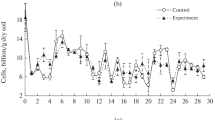Abstract
The number of bacterial cells in soil that form colonies on nutrient agar represent a small fraction of the direct microscopic counts (DMC). The colony-forming cells have larger cell dimensions than the very small (“dwarf”) cells which represent the majority of the DMC. This may indicate that the dwarf cells are species unable to form visible colonies on agar, or that they swell to normal dimensions when growing. Indigenous bacterial cells were separated from soil by density gradient centrifugation and fractionated according to diameter by filtration through polycarbonate filters. Each filtrate was studied with respect to DMC, cell dimensions, colony-forming cells (visible colonies and microcolonies), and cell dimensions during growth on the agar. The calculated average percent viability was only 0.2% for cells with diameters below 0.4μm, about 10% for cells with diameters between 0.4 and 0.6μm, and 30–40% for cells with diameters above 0.6μm. Only 10–20% of the viable cells with diameters <0.4μm increased their diameter to >0.4μm prior to growth. Thus, size change during starvation and growth cycles did not explain the high numbers of dwarf cells observed by microscopy. The results show that despite the relatively low number of colony-forming bacteria in soil, the species that form colonies may be fairly representative for the medium size and large cells, which constitute a major part of the bacterial biovolume. Thus plate counting could be a useful method to count and isolate the bacteria accounting for much of the biovolume in soil. The origin of the dwarf cells is still unclear, but the low number of small cells that increased in size seems to indicate that the majority of these bacterial cells are not small forms of ordinary sized bacteria.
Similar content being viewed by others
References
Amy PS, Morita RY (1983) Starvation-survival patterns of sixteen freshly isolated open water bacteria. Appl Environ Microbiol 45:1109–1115
Bae HC, Casida LE (1973) Responses of indigenous microorganisms to soil incubation as viewed by transmission electron microscopy of cell thin sections. J Bacteriol 113:1462–1473
Bakken LR (1985) Separation and purification of soil bacteria by density gradient centrifugation. Appl Environ Microbiol. 49:1482–1487
Bousfield IJ, Smith GL, Trueman RW (1973) The use of semi-automatic pipets in the viable counting of bacteria. J Appl Bacteriol 36:297–299
Casida LE Jr (1977) Small cells in pure cultures ofAgromyces ramosus and in natural soil. Can J Microbiol 23:214–216
Dow CS, Whittenbury R (1980) Procaryotic form and function. In: Ellwood DC, Hedger JN, Latham MJ, Lynch JM, Slater JH (eds) Contemporary microbial ecology pp 391–417
Fægri A, Torsvik VL, Goksøyr J (1977) Bacterial and fungal activities in soil: separation of bacteria and fungi by a rapid fractionated centrifugation technique. Soil Biol Biochem 9:105–112
Fry JC, Davies AR (1985) An assessment of methods for measuring volumes of planktonic bacteria with particular reference to television image analysis. J Appl Bacteriol 58:105–112
Fry JC, Zia T (1982) Viability of heterotrophic bacteria in freshwater. J Gen Microbiol 128: 2841–2850
Hattori T (1985) Kinetics of colony formation of bacteria. Reports of Inst Agric Res Tohuko University (Japan) 34:1–36
Hobbie JE, Daley RJ, Jaspen S (1977) Use of Nucleopore filters for counting bacteria by fluorescence microscopy. Appl Environ Microbiol 13:1225–1229
Kjelleberg S, Humphrey BA, Marshall KC (1983) Initial phases of starvation and activity of bacteria at surfaces. Appl Environ Microbiol 46:978–984
Lund V, Goksøyr J (1980) Effects of water fluctuations on microbial mass and activity in soil. Microb Ecol 6:115–123
Luscombe BM, Gray TRG (1974) Characteristics of Arthrobacter grown in continuous culture. J Gen Microbiol 82:213–222
May KR (1965) A new graticule for particle counting and sizing. J Sci Instruments 42:500–501
Mazia D, Schatten G, Sale W (1975) Adhesion of cells to surfaces coated with polylysine: applications to electron microscopy. J Cell Biol 66(1):198–200
Morita RY (1982) Starvation-survival of heterotrophs in the marine environment. Adv Microbial Ecol 6:171–198
Novitsky JA, Morita RY (1976) Morphological characterization of small cells resulting from nutrient starvation of psychrophilic marine vibio. Appl Environ Microbiol 32:617–622
Olsen RA, Bakken LR (1987) Viability of soil bacteria: optimization of the plate-counting technique. Microb Ecol 13:59–74
Schmidt EC (1973) The traditional plate-count technique among modern methods. Bull Ecol Res Comm 17:453–454
Tabor PS, Ohwada K, Colwell RR (1981) Filterable marine bacteria found in the deep sea: distribution, taxonomy and response to starvation. Microb Ecol 7:67–83
Torella F, Morita RY (1981) Microcultural study of bacterial size changes and microcolony and ultramicrocolony formation by heterotrophic bacteria in seawater. Appl Environ Microbiol 41:518–527
Zierdt CH (1979) Adherence of bacteria, yeast, blood cells and Latex spheres to large-porosity membrane filters. Appl Environ Microbiol 38:1116–1172
Author information
Authors and Affiliations
Rights and permissions
About this article
Cite this article
Bakken, L.R., Olsen, R.A. The relationship between cell size and viability of soil bacteria. Microb Ecol 13, 103–114 (1987). https://doi.org/10.1007/BF02011247
Issue Date:
DOI: https://doi.org/10.1007/BF02011247




